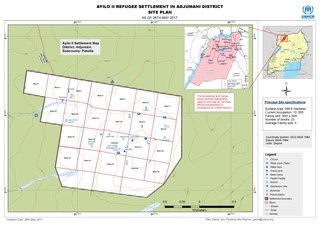Related Research Articles
Sudanese refugees are persons originating from the country of Sudan, but seeking refuge outside the borders of their native country. In recent history, Sudan has been the stage for prolonged conflicts and civil wars, as well as environmental changes, namely desertification. These forces have resulted not only in violence and famine but also the forced migration of large numbers of the Sudanese population, both inside and outside the country's borders. Given the expansive geographic territory of Sudan, and the regional and ethnic tensions and conflicts, much of the forced migration in Sudan has been internal. Yet, these populations are not immune to similar issues that typically accompany refugeedom, including economic hardship and providing themselves and their families with sustenance and basic needs. With the creation of a South Sudanese state, questions surrounding southern Sudanese IDPs may become questions of South Sudanese refugees.
By January 2011 the United Nations High Commissioner for Refugees (UNHCR) estimated that there are 262,900 Sudanese refugees in Chad. The majority of them left Sudan escaping from the violence of the ongoing Darfur crisis, which began in 2003. UNHCR has given the Sudanese refugees shelter in 12 different camps situated along the Chad–Sudan border. The most pressing issues UNHCR has to deal with in the refugee camps in Chad are related to insecurity in the camps,, malnutrition, access to water, HIV and AIDS, and education.

South Sudan, officially known as the Republic of South Sudan, is a landlocked country in east/central Africa. It is bordered to the east by Ethiopia, to the north by Sudan, to the west by the Central African Republic, to the southwest by Democratic Republic of the Congo, to the south by Uganda and to the southeast by Kenya. It has a population of 11.06 million, of which 525,953 live in the capital and largest city Juba.
Education in South Sudan is modelled after the educational system of the Republic of Sudan. Primary education consists of eight years, followed by four years of secondary education, and then four years of university instruction; the 8 + 4 + 4 system, in place since 1990. The primary language at all levels is English, as compared to the Republic of Sudan, where the language of instruction is Arabic. There is a severe shortage of English teachers and English-speaking teachers in the scientific and technical fields.
South Sudanese refugees are persons originating from the African country of South Sudan, but seeking refuge outside the borders of their native country. The world's youngest independent country has a recent and troubled history of prolonged conflicts and ecosystem mismanagement such as overlogging, which has led to desertification. These forces have resulted not only in violence and famine, but also the forced migration of large numbers of the population, both inside and outside the country's borders. South Sudan was cited as the largest refugee crisis in 2016, being the world's third largest, followed by Syria and Afghanistan.

Kyangwali Refugee Settlement is a refugee camp in Kikuube District in western Uganda.

Rhino Camp Refugee Settlement is a refugee camp in the districts of Madi-Okollo and Terego in northwestern Uganda. It was opened in 1980 and expanded in the wake of the South Sudanese civil war to host the sudden influx of refugees into Northern Uganda. As of January 2018, the settlement had 123,243 registered refugees, mostly South Sudanese, and continues to receive new arrivals.

Pagirinya Refugee Settlement is a refugee camp in Eastern Adjumani District in Northern Uganda.

Bidibidi Refugee Settlement is a refugee camp in northwestern Uganda. With over 270,000 South Sudanese refugees fleeing the ongoing civil war, as of early 2017 it was the largest refugee settlement in the world. As of 2018, that distinction was claimed by Kutapalong refugee camp for displaced Rohingya in Bangladesh.

`

Palorinya Refugee Settlement is a refugee camp in Moyo District in North Western, West Nile region of Uganda.

Alere 2 Refugee Settlement is located in Adjumani District in the Northern Region of Uganda.
Baratuku refugee settlement is a refugee settlement in Adjumani district Uganda
Mungula II Refugee Settlement is a refugee camp found in Adjumani District Itirikwa subcounty. in Northern Uganda.
Olua I Refugee settlement is a refugee camp in eastern Adjumani District in Northern Uganda. The Refugee settlement has its primary country as Uganda and other country south Sudan.
Mungula refugee settlement is located in Adjumani district in northern Uganda on the border with South Sudan.
Oliji refugee settlement is a refugee camp in Adjumani District of Uganda.

Boroli refugee settlement is a refugee camp located in the Pakele Sub County of Adjumani District Northern Region, of Uganda.

Ayilo 2 refugee settlement is one of the refugee camps in Adjumani District in the Northern Region of Uganda.
The Maaji refugee settlements are three refugee camps located in Adjumani District in the Northern Region of Uganda, established in 1997. In June 2018, there were 41,764 registered refugees, accounting for 10% of the district's total population. It has primarily admitted refugees from the Second Sudanese Civil War and the ongoing South Sudanese Civil War. The settlements have been attacked several times by the Lord's Resistance Army, along with other camps in the region such as the Baratuku refugee settlement.
References
- 1 2 "Uganda Refugee Response Monitoring: Settlement Fact Sheet: Mirieyi (June 2018) - Uganda". ReliefWeb. Archived from the original on 2020-09-22. Retrieved 2020-09-28.
- ↑ "Education report of the LWF" (PDF). Archived (PDF) from the original on 2021-10-28.